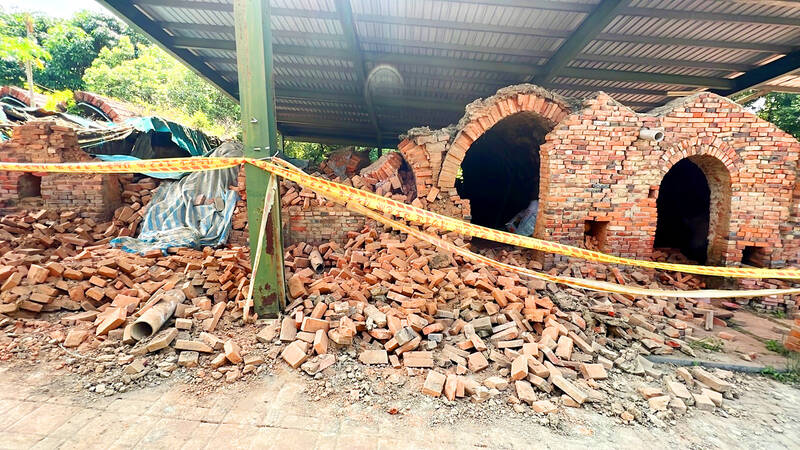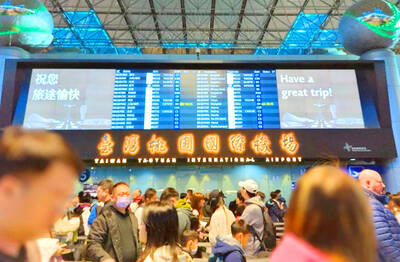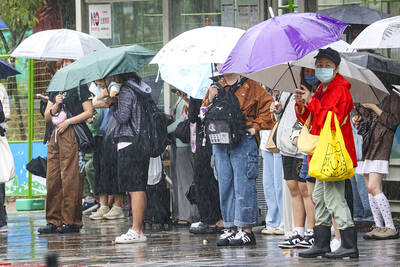Taitung County residents received national earthquake alerts on their mobile phones more frequently over the past year than people in other parts of Taiwan, Central Weather Bureau data showed.
Between Nov. 20 last year and Nov. 20, Taitung residents topped other administrative regions with 20 earthquake alerts. They were followed by Hualien County residents who received 17 alerts and Chiayi County residents who received 11, the bureau said.
Residents in Penghu, Kinmen and Lienchiang counties did not receive a single earthquake alert, it said.

Photo: CNA
The bureau shared the data on Facebook for the first time since the government connected the earthquake warning system to the cellphone broadcasting system in 2016, enabling people to receive earthquake alerts.
Several strong earthquakes occurred from Sept. 17 to Sept. 19, one of which was a magnitude 6.8 temblor at 2:44pm on Sept. 18 that was centered in Taitung’s Chihshang Township (池上), the bureau said.
Earthquakes happen frequently in Taiwan as it lies at the junction of two tectonic plates, the bureau said, adding that the national earthquake alert system was created to warn people to evacuate areas as soon as possible before shaking starts.
However, to prevent the public from being constantly bombarded by warning messages about small and medium-sized earthquakes, which generally do not lead to disasters, two conditions were set for the dissemination of messages: An earthquake must be estimated to be of magnitude 5 or greater or able to generate shaking intensity of 4 or greater, the bureau said.
Even if the magnitude of an earthquake is estimated to be greater than 5, warning messages are not sent out if the estimated intensity of the earthquake in a specific area does not reach 4, it said.
The system protects everyone, Central Weather Bureau Director-General Cheng Ming-dean (鄭明典) said.
“If there are too many alarms on your smartphones, it means you are facing risks; if there are too few alarms, it means you are in a relatively stable geological area,” he said.

Temperatures in northern Taiwan are forecast to reach as high as 30°C today, as an ongoing northeasterly seasonal wind system weakens, the Central Weather Administration (CWA) said. CWA forecaster Tseng Chao-cheng (曾昭誠) said yesterday that with the seasonal wind system weakening, warmer easterly winds would boost the temperature today. Daytime temperatures in northern Taiwan and Yilan County are expected to range from 28°C to 30°C today, up about 3°C from yesterday, Tseng said. According to the CWA, temperature highs in central and southern Taiwan could stay stable. However, the weather is expected to turn cooler starting tonight as the northeasterly wind system strengthens again

The Ministry of Foreign Affairs (MOFA) yesterday expressed “grave concerns” after Singaporean Prime Minister Lawrence Wong (黃循財) reiterated the city-state’s opposition to “Taiwanese independence” during a meeting with Chinese Premier Li Qiang (李強). In Singapore on Saturday, Wong and Li discussed cross-strait developments, the Singaporean Ministry of Foreign Affairs said in a statement. “Prime Minister Wong reiterated that Singapore has a clear and consistent ‘one China’ policy and is opposed to Taiwan independence,” it said. MOFA responded that it is an objective fact and a common understanding shared by many that the Republic of China (ROC) is an independent, sovereign nation, with world-leading

Foreign travelers entering Taiwan on a short layover via Taiwan Taoyuan International Airport are receiving NT$600 gift vouchers from yesterday, the Tourism Administration said, adding that it hopes the incentive would boost tourism consumption at the airport. The program, which allows travelers holding non-Taiwan passports who enter the country during a layover of up to 24 hours to claim a voucher, aims to promote attractions at the airport, the agency said in a statement on Friday. To participate, travelers must sign up on the campaign Web site, the agency said. They can then present their passport and boarding pass for their connecting international

COOLING OFF: Temperatures are expected to fall to lows of about 20°C on Sunday and possibly 18°C to 19°C next week, following a wave of northeasterly winds on Friday The Central Weather Administration (CWA) on Sunday forecast more rain and cooler temperatures for northern Taiwan this week, with the mercury dropping to lows of 18°C, as another wave of northeasterly winds sweeps across the country. The current northeasterly winds would continue to affect Taiwan through today, with precipitation peaking today, bringing increased rainfall to windward areas, CWA forecaster Liu Pei-teng (劉沛滕) said. The weather system would weaken slightly tomorrow before another, stronger wave arrives on Friday, lasting into next week, Liu said. From yesterday to today, northern Taiwan can expect cool, wet weather, with lows of 22°C to 23°C in most areas,